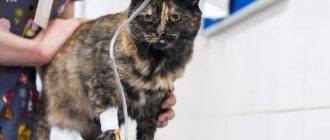The purpose of the injection is to quickly deliver the medicine and get a quick therapeutic effect. Cats, no less than people, may need treatment, and in addition to tablets and mixtures, there are drugs available in the form of injections. Not everyone can do it on their own give an injection at home for your own pet.
If a one-time injection is required, then you can take the cat to a veterinarian, who will perform an examination and give advice after all the manipulations. But if you need to follow a certain treatment regimen and give injections every day, in this case it is easier to learn how to do everything yourself.
Giving an injection correctly is a simple science: you need to know how to prepare a cat for the procedure, select and fill a syringe, and also learn about possible complications from administering the drug.
How to prepare a cat for an injection
global $ads_google; //data-ad-slot=”2475549904″ $ads_google = empty($ads_google) ? false : true; ?> if ($ads_google == false) {?>
$ads_google = true; ?> } ?>
Expecting that a cat will appreciate the owner’s desire to stick a syringe into his body is, to say the least, naive: definitely, a furry friend will not approve of violence during such manipulations. The first thing the owner needs to do is to realize that this is not a means to torment the unfortunate kitty, but to help the animal regain its health. It is with this thought that you should approach your pet.
Features of injections in animals
Some medications require a subcutaneous injection, meaning the needle only needs to pierce the skin. For most pets, the best places for this type of surgery are behind the neck and shoulder blades. To facilitate injections, a portion of this skin is taken to form a “skin tent”. Drugs (non-irritating and water-soluble) are deposited in loose connective tissue just below the dermis. The absorption rate is low because there are not many blood vessels in this area. Loose skin on the shoulders and neck are ideal injection sites for dogs. For a cat, skin in the middle of the back or just behind the shoulders works well.
Other medications will only work if they are injected into the muscles. This is due to the fact that intramuscular tissue is rich in blood, and thus the medicine is absorbed faster. These intramuscular injections are usually given in the neck, chest, buttocks or hind leg, however, this may vary depending on the animal. There are fewer pain receptors in muscle tissue, making it an ideal location for more irritating or viscous medications.
Where to give an injection to a cat
Despite the fact that, in theory, you can hit it almost anywhere, there are places on the animal’s body where it will be more effective and less painful. The cat can be injected subcutaneously into the withers (between the shoulder blades) or intramuscularly into the thigh. The muscle tissue of the thigh has a large number of vessels, so any injected medicine is very quickly delivered to the blood. An injection is given into the thigh if the drug is not very painful. In some cases, intramuscular administration is preferable, so you should carefully read the instructions. Intramuscular injections are limited in volume - liquid injected inside causes greater muscle separation, which is a microtrauma.
The skin on the withers is denser, so it is better to address “painful” solutions to this particular place - just remember how animals fight and grab each other precisely by it.
Beauty salon for pets. Haircut and grooming at home
In addition to emergency veterinary care at home, our animal clinic specialists will help care for your pet. The masters of the veterinary clinic's exemplary grooming salon will give your pet a chic and well-groomed aesthetic appearance. They will carry out the necessary cosmetic and hygienic procedures without causing inconvenience to the animal, as they constantly study the behavioral characteristics of various breeds and systematically improve their skills.
By contacting the 24-hour animal care clinic in Moscow and the Moscow region “Home Veterinarian,” you provide your pet with strong immunity, caring care, and a healthy, interesting and long life.
How to give a cat an intramuscular injection
Injecting a cat in the thigh requires compliance with several rules:
- sterility of hands and syringes;
- exact injection dosage (not from the “I know better than a specialist” series);
- correct set of drug;
- mixing two medications in one syringe without a veterinarian’s prescription is unacceptable;
- insertion accuracy.
The syringe is removed from the package. If you have no experience injecting cats into muscles, then it is better to prepare 2-3 syringes: if one falls out of your hands, you can immediately take another without making the cat nervous.
Observing the accuracy of the dosage, take the medicine and, independently or with an assistant, fix the animal in any way. To prevent the cat from twitching when the needle is inserted, the animal is pressed with the elbow of the free hand.
For a cat weighing 4 kg, no more than 1-1.5 ml of medication is injected into the paw. The animal's skin does not need to be disinfected.
Before making an injection in the leg, find the right place. This is a muscle on the hind leg near the knee bend. It is important to hit the muscle and not the joint. The needle is inserted at an angle of 45°. The insertion depth should be 1-1.5 cm.
to give an intramuscular injection to a cat for the first time , but it is not difficult to do it correctly.
What vaccinations should a cat have and how long does it take to develop immunity?
Among the necessary vaccinations for cats, the most important are the following:
- Vaccination against calicivirus or herpesvirus infection, panleukopenia and rhinotracheitis. These diseases are scary not only with a high risk of death, but also with dangerous consequences in the future. This vaccine is most often complex and protects against three diseases at once. Domestic and imported vaccines are available on the market. I use imported ones.
- Vaccination against rabies. This vaccination will protect both your pet and you if your pet comes into contact with a sick animal. In state veterinary clinics, domestic rabies vaccinations are given free of charge.
There are some other vaccinations, but the ones listed above are the most important.
Lasting immunity from vaccinations takes a year to develop. Some doctors say that vaccination against three infections (calicivirus, panleukopenia, rhinotracheitis) actually protects for up to three years, immunity to them fades gradually. But if the animal is healthy and there are no contraindications, then it is better to revaccinate annually. Personally, I stick to an interval of no more than 1.5 years between vaccinations.
How to give an injection to a cat at the withers
If the medicine is quite painful and also of large volume, it is better to insert the needle with the medicine subcutaneously. To correctly give an injection at the withers, no special experience is required. If when administered intramuscularly there is a chance of getting into a joint, then there is nowhere else to get there other than in the right place. Why is it easier to administer medicine here? Because the animal finds itself in a “mother cat and kitten” situation, when the mother carried the stupid little one in her teeth precisely by the withers. Therefore, it is easier to immobilize the animal, but it is still better to ask an assistant about this - the skin in this place is very thick, and sometimes it is not easy to pierce it.
global $ads_google; //data-ad-slot=”2475549904″ $ads_google = empty($ads_google) ? false : true; ?> if ($ads_google == false) {?>
$ads_google = true; ?> } ?>
The procedure for preparing the syringe is the same as for injection into the animal’s thigh.
The direction of the needle should be strictly at an angle of 45°. The fold on the neck is pulled up, and the injection is made at the base of the withers. The cat's head is pressed with a free hand or an assistant. The lower back also needs to be pressed so that the cat does not twitch and cause pain to itself. During the insertion of the needle, the resistance of the skin layer will be clearly felt - but as soon as it stops, it means that the needle is inserted and you can release the syringe plunger. Do not rush when inserting the needle - you can accidentally pierce the skin through.
It doesn’t matter at what speed the medicine is injected, the volume should not exceed 90 ml per 1 kg of weight. If a larger amount is required, the syringe itself is changed and the needle is left in place.
Once the medication has been completely injected, the needle can be removed and the animal released.
Is it worth vaccinating if your cat lives at home?
As soon as I got a kitten, I planned to vaccinate it.
But somehow I didn’t immediately get vaccinated; I thought that this process could be postponed, especially since the animal lives at home. My cat has been house-kept since birth and does not know the streets, except for rare outings when necessary (veterinary clinic, transportation when moving).
Since I didn’t take my Mars for vaccination at an early age, I managed to become familiar with the consequences of such negligence on my part. At the age of 8 months, my cat suffered from panleukopenia, or, as it is otherwise called, distemper.
We caught it in time and started treatment, so the disease passed without consequences. In fact, panleukopenia is quite often fatal.
From that moment on, I am 100% sure that pets, even if they never leave the apartment, need to be vaccinated. We ourselves can bring viruses and bacteria on street shoes.
If you injected your cat incorrectly
Not everyone knows how to give injections to animals, like Aibolit, and even if you do them more than once, you can make a mistake and give the injection in the wrong place. It happens that the procedure itself seemed to go well, but after it the cat began to limp and hit everything when walking. Most likely, the needle hit the sciatic nerve. If this is the case, then you can rub the affected area a little - after 2-3 days the animal will walk and run again as before.
Sometimes it happens that the injected medicine is not completely absorbed. The instructions usually indicate that a side effect of the drug may be an abscess. In this case, a lump will form at the injection site, and it is obvious that the cat will be in pain: you should not wait, but contact a veterinarian as soon as possible. He will pump out the resulting fluid and inject medicine that will help the lump resolve and eliminate the abscess.
Subcutaneous injections
Such injections are needed in various cases. For example, with heat stroke, dehydration. Vaccines and antiparasitic drugs can be injected under the skin.
This is a simple manipulation, but the animal owner cannot always carry it out correctly. In order for the procedure to take place with minimal pain, it is better to entrust it to a doctor.
It is important to use the correct technique. Usually the drug is injected into the area of the shoulder blade or the lower third of the neck. A small bump appears in the area where the drug was administered. The injection site is treated.
Where to give a cat an injection for cats
Well, you don’t want a kitten at all, and it’s not easy to survive the cat’s heat period? In this case, the issue is resolved by sterilizing the animal. But for some reason, some owners believe that there is nothing easier than suppressing the reproductive instinct, forgetting that the consequences of such a decision can be very dire.
If you definitely want to experiment with your cat and give her a cat injection, then you will still have to visit the veterinarian - this should be the moment before the start of estrus, and not during it. The doctor will administer the medicine himself, and then, after 3 months, the next injection will be given according to the schedule. The third ampoule is administered after 4 months, and all subsequent ones every 5 months.
Why shouldn't you give injections yourself ? This is a big risk even without an inexperienced person, so the entire process must be supervised by a doctor.
Where should the vaccination be given - at a veterinary clinic or at home?
For the first few years of my cat's life, I gave him vaccinations at the veterinary clinic. And for three years now I have been doing vaccinations myself at home.
For myself, I can note the following advantages of vaccination in the clinic:
- You don’t need to do anything yourself - you came with the animal, the doctor examined it and vaccinated it.
- After vaccination, official vaccination data with the date and seal of the organization is entered into the animal’s passport. Vaccination in a clinical setting is necessary if you need to provide this information anywhere - for competitions, during international flights, and so on.
- In case of allergies, the animal will receive immediate assistance.
Minuses:
- Price. Since in a clinic setting we pay not only for the vaccination itself, but also for the vaccination service, on average the cost of vaccination will be twice as high as if we do it ourselves.
- You need to spend time - getting with a nervous animal to the clinic, waiting for your turn, and going back.
- While you are in the clinic, the animal comes into contact with others, including sick pets. Theoretically, your cat could become infected with some kind of airborne infection, although I think this is unlikely. Moreover, in good clinics, the premises are disinfected and quartzed every 2-3 hours.
Advantages of vaccination at home:
- You don't need to go anywhere. In 10 minutes you can get all the vaccinations. And the animal does not behave so restlessly.
- The cost is two times lower. We buy a vaccine at a veterinary pharmacy (make sure that the drug sold is in the refrigerator and not on the display) and vaccinate.
Minuses:
- You need to learn how to give injections. In fact, this skill can be trained quite quickly.
- After vaccination, there will be no official stamp in the passport. Although I always put a vaccination sticker on myself and put the date on it so I can remember when to get the next one. My cat does not need to carry official proof of vaccination anywhere, so for me this type of vaccination is preferable.
If you know that your cat does not tolerate vaccinations well, of course, you should not give them at home. However, reactions to these two vaccinations are rare and animals tolerate them well.
How much does it cost to give an injection to a cat?
It is not necessary to give injections yourself - not everyone is capable of causing pain to a pet, even for the purpose of healing. In this case, the solution would be to visit a veterinary clinic or call a specialist home. The doctor knows very well how quickly to administer an antibiotic or other medicine.
The price list for each hospital is different. Prices also depend on the site of administration - intravenous, subcutaneous, intramuscular. The minimum price starts around 400 rubles.
If you call a doctor at home, you will have to pay about 800 rubles for the injection. Typically, clinics with visiting doctors work around the clock, which also plays a role.
global $ads_google;
//data-ad-slot=”2475549904″ $ads_google = empty($ads_google) ? false : true; ?> if ($ads_google == false) {?> $ads_google = true; ?> } ?>
Why calling a veterinarian is better than coming to the clinic
Calling the veterinarian may be necessary at the most inopportune time - at night, on a holiday or weekend. A trip to the veterinary clinic is not always justified and is not always possible either. An on-site veterinarian is a modern, highly sought-after service in a modern metropolis. She is increasingly in demand. And more and more veterinarians travel at the request of our clients to all localities of Moscow and the region. In addition to the fact that you don’t have to stand in hours-long traffic jams, this type of veterinary service has many more advantages:
- The animal is not subject to unnecessary stress
- The pet does not come into contact with other animals. This eliminates infection from other individuals
- You are not wasting your time. Our veterinarian will come to your home in any district of Moscow at a time convenient for you. Calling a veterinarian will only take you a couple of minutes.
- All veterinary services in one place. Our mobile team of veterinarians is equipped with the essentials to provide care at home. The most modern portable equipment, a sterile surgical unit for sterilization of cats, castration of cats, high-quality medications.
- The team includes veterinarians of various specialties (veterinarian-therapist, veterinary surgeon, urologist, traumatologist, cardiologist, ophthalmologist).
- Diagnosis of animals is now possible at home (ultrasound, X-ray, ECHO CG in a mobile veterinary office.)
Animal injections at home
Each therapy is different. Many of them involve different types of animal injections. Injections are administered using different methods, most often intramuscularly, subcutaneously or intravenously. They must be carried out according to certain rules that the doctors of our clinic know.
- Intradermal injection for animals - from 200 rubles. It is carried out quickly and painlessly. The medicine is injected under the skin with one syringe, most often in the withers area.
- V\m and subcutaneous injection - from 200 rubles. Subcutaneous and intramuscular injections are performed for effective treatment. This is a safe manipulation that lasts 5-10 minutes.
- IV injections - from 500 rubles, IV drips - from 1,000 rubles. An intravenous injection is the most effective of all types; the medicine is injected into a vein and it quickly spreads throughout the animal’s body, which is why it begins to act quickly. If the volume of the drug is large, a dropper is placed.
- Subconjunctival administration - from 1,000 rubles. Drops and ointments in the eye are used as treatment and preventive measures for conjunctivitis of any form.
- Intralingual injection - from 600 rubles. Creams, gels and ointments are injected into the mouth with a syringe.
- Intra-articular injection - from 1,500 rubles. Injections are made into the animal's joint using a syringe with a thin needle. The procedure requires concentration and precision in execution, so it should be entrusted to our doctors.
- Intracavitary injections - from 1,500 rubles. This is an injection for the chest and abdominal area of the pet. The procedure is not the most pleasant, so this procedure should be entrusted only to a specialist who has found an approach for your pet.
- Intracardiac administration - from 2,500 rubles. An effective manipulation, but it causes great discomfort to the animal. Veterinarians use a set of tools to do this. With their help, the medicine is delivered to the heart muscle.
- Intraosseous injection —RUB 7,000. A complex procedure during which doctors inject a drug into the bone. Should only be performed in clinical sterile conditions under the supervision of experienced physicians.
- Application of a plaster cast - from RUB 3,000. If a pet has injured its limbs or other parts of the body, it, like people, is given a plaster cast. These manipulations require quite a long time so that all layers are applied evenly, in the right direction. They do not cause pain.
- Autohemotherapy for pets - from 2,500 rubles. Reminds me of a blood transfusion. Blood from an animal's vein is injected under the skin or into a muscle.
- Perinephric blockade - from 600 rubles. Performed to relieve pain in some cases. Instead of spasm, novocaine is administered. The medicine relaxes the nerve plexuses, easing the patient's condition.
- Treatment of postoperative suture - from 500 rubles. After surgery, the sutures should be treated 1-3 times a day. For this purpose, solutions, ointments, and sterile dressings are used. Manipulations help the wound to heal, prevent inflammation and blood poisoning.











